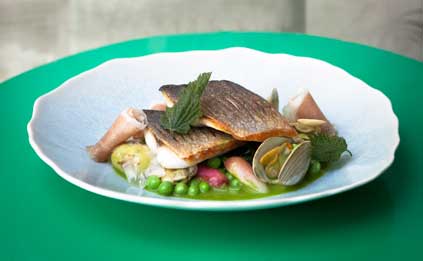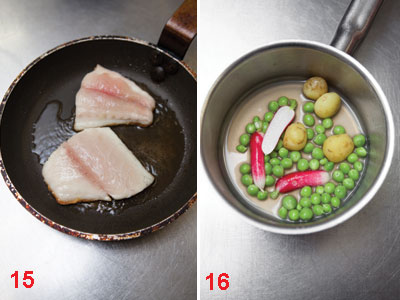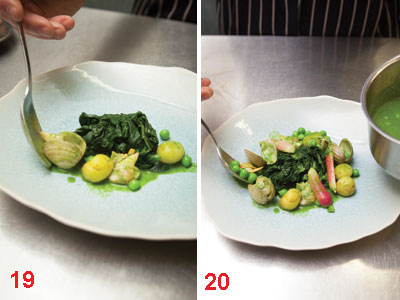Masterclass – Gilthead Bream
Joe Mercer Nairne of Chelsea restaurant Medlar cooks gilthead bream with Venus clams and nettles. Michael Raffael reports
The 'royal' tag may owe more to its good looks - it has a golden blush spreading over its face - but its firm texture and clean taste are what make it valuable. Along with bass it's the species that dominates aquaculture around the Mediterranean. Whereas somebody with a refined palate and experience might be able to tell wild from farmed bass (ditto for salmon or turbot), aquaculture-produced gilthead is less of a poor relation.
Gilthead also receives a thumbs-up from the Marine Conservation Society, which rates it as "a good sustainable fish to eat".
Freshness and yield
According to chef Mercer Nairne, suppliers encourage restaurants to buy whole gilthead bream, weighing 400g-600g, which will yield two portions. Nairne prefers larger 600g-800g ungutted fish and offers more generous servings. It is also possible to find specimens larger than one kilo.
Mercer Nairne receives daily deliveries from Fish For Thought and The Upper Scale, and his suppliers receive three shipments a week from Greece, Turkey and Bulgaria. Aquaculture farms claim their bream will arrive in the UK with a shelf life of five to seven days.
Fishmongers offer customers the option of pin-boned fillets, but seeing the whole fish is the only effective judgement of quality. The usual pointers (bright eyes, red gills and blood along the backbone) are accurate indicators of freshness. Having the bream's scales removed by your supplier can save time.
Costing
Nairne pays about £8.50 per kg and each fillet costs approximately £2.80. The completed dish, with clams, nettles and lardo, costs about £4.20.
The restaurant serves a £27 three-course lunch menu, or a £22 two-course menu, and charges £19 for a main course only. The £45 dinner menu is similar, but with
additional choices.
Planning
- The kitchen prepares up to 20 portions of the dish a day
- The fish is prepped immediately after the morning delivery
- The clams are opened and cleaned
- The nettle butter is prepared
- The nettle tops are deep-fried
- The mise-en-place for the trimmings is prepared
- The fish is fried to order and the nettle butter and clam jus are heated at the same
Filleting All types of bream are classed as round white fish, so although chefs could use the standard filleting technique, Mercer Nairne uses a method he learned at the Savoy Grill, using a traditional, thin-bladed filleting knife.
In this method, the fish has already been scaled but not gutted. Lay the fish in front of you. Where the head joins the backbone, cut a straight line through the flesh down to the belly (1). Keep as close to the pectoral fin as possible.
Turn the fish over and make the same cut on this side. Leave the head attached to the spine.
Keeping the knife edge flush against the backbone, slice through the flesh from the head end, behind the dorsal fin and down to the tail.
Don't remove the fillet completely, but leave it attached by a flap to the body. Turn the fish over again. Make the same cut on this side of the backbone. The two flaps of
fish fillets will open like a book with the backbone between them (2).
Cut off the two fillets (3) and discard the head, bones and innards. Lay the fillet skin-side down and trim the membrane over the belly (4). Pin-bone the half dozen bones running through the centre of the fish (5). Cut each fillet in half and lay it skin-side up.
Make half a dozen shallow slashes through the skin to prevent it curling up during frying (6).
Rinse the clams for one hour under running water.
Preheat a large casserole on top of the range. When the base is hot, add the clams and wine (7). Cover with a lid and boil for about a minute to open the clams (8).
Take the clams out of the liquid. Cool and then remove the meat from the shells (9).
Pass the liquid into a bowl through a chinois lined with muslin (10). Rinse the clam meat in the liquid to remove any additional grit (11). Remove the clam meat and reserve. Strain the clam liquid through muslin again and reserve.
GILTHEAD BREAM, VENUS CLAMS AND NETTLES
Serves 1
- 30ml sunflower oil or pomace
- 1 halved bream fillet
- 2 radishes, split lengthways
- 2tbs freshly shelled peas
- 2-3 small, steamed, Jersey Royal new potatoes
- 2tbs clam cooking liquid
- 1tbs water
- 2tbs nettle butter
- Salt
- Squeeze of lemon juice
- 6 cooked clams
- 40g wilted spinach
- 2 wafer-thin slices Italian speck (similar to smoked prosciutto)
- 2 slices lardo di Colonnata
Put the oil in a cold frying pan just large enough to hold the fish. Add the fish skin-side down (15). Fry it without turning for about three minutes. Check that the
skin is nicely coloured and crisp. Take it off the heat and reserve.
Put the radishes, peas and potatoes in a small pan with the clam liquid and water (16). Heat through. Add the nettle butter (17) and shake the pan until the butter
emulsifies and forms an intense, green sauce (18). Check the seasoning and add a small squeeze of lemon juice. Keep hot, but don't boil. Just before serving, add the
clams and a couple of the shells. Turn over the fish in the pan only when you start to dress the plate.
Pile the spinach in the centre of the plate (19), and spoon over the clam nettle sauce and the vegetables (20). Lay the two pieces of fillet on top and finish with the
speck, the lardo and the clam shells.
Tips
•After filleting the fish, it's normally better not to rinse it. It can be rinsed after scaling.
•The filleting method described above is much easier than the classic method of removing one fillet and struggling with the second.
•Using a cold pan and oil when starting to cook the fish stops it from curling up at the edges. Chefs often have to press it into shape with a palette knife.
•The unilateral technique for frying the fillet makes it unlikely that the fillet will be overcooked.
JOE MERCER NAIRNE
Look around Joe Mercer Nairne's kitchen at Medlar restaurant and you won't see a water bath, a Thermomix or a Pacojet. It's a bit like stepping back in time.
Before buying Medlar with his business partner David O'Connor three years ago, Mercer Nairne spread his career between the Savoy Grill, Carluccio's, Chez Bruce and Neil Perry's Rockpool in Sydney. By this pedigree he's a chef who puts more emphasis on what was once called cuisine bourgeoise.
"We don't do small portions and tasting menus," he says. "If you order beef, you want beef, not a cube on a plate."
With this approach, his and O'Connor's "neighbourhood" bistro has been an immediate success with Chelsea residents and also discerning regulars such as Marcus Wareing.
FARMED VS WILD
There are minor differences between farmed and wild gilthead bream. Farmed fish tend to be a little plumper and fattier, although they aren't oily. The skin of farmed fish may also be a touch thicker and darker. There are various aquaculture techniques for farming the fish, ranging from pools to ponds and cages.
In the wild, gilthead bream can grow to 5kg, although large specimens like this are rare. Wild fish are seasonal from early summer until autumn.
Deep-fried nettles
Deep-fry sprigs of nettle tops in oil at 160°C until crisp - a few seconds. Drain on absorbent paper and season.
NETTLE BUTTER
Ingredients
100g nettle tops without stems
60g flat-leaf parsley
200g-250g hot, melted butter
Blanch the nettles for 30 seconds in boiling water. Drain and squeeze out the excess moisture. Blanch the parsley in boiling water, drain and squeeze out the excess moisture.
Put both the nettles and parsley in a professional blender and blitz. Add the butter and continue blending until they are smooth. Pass as much of the purée through
a sieve as possible without forcing it.
















